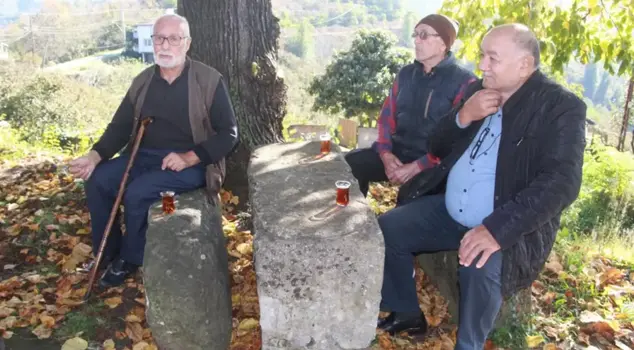
01.11.2024 10:11
In the Fatsa district of Ordu, a stone milestone inscribed from around 239 AD during the Roman Empire has been used as a bench in the courtyard of a mosque for 56 years. The stone, identified as an important historical artifact, has been removed from the mosque courtyard and taken to the Ordu Museum.
During the excavation of the foundation of the Laleli Central Mosque, built in 1968 in the Bolaman neighborhood of Fatsa district, a stone was discovered. At that time, citizens were suspicious because there were writings on the stone. After the necessary discussions, the citizens decided to place the stone in the mosque's garden as a seat, as it had a proper structure, when they could not obtain any results.
THEY SAT ON THOUSANDS OF YEARS OF HISTORY
Without knowing its importance and meaning, citizens have been sitting on the stone they used as a seat since the 1970s, resting, and the congregation and guests have chatted here for years. However, Aydın Bal, a literature teacher at Fatsa Cahit Zarifoğlu Anatolian High School and a local resident, noticed the writings on the stone years later and informed Cevat Erbil, the Director of Culture and Social Affairs of Fatsa Municipality. Following this, after the initial examinations conducted with the participation of academics from Ordu University, the Latin text was translated by Prof. Dr. Hüseyin Sami Öztürk, an expert in ancient Greek and Latin epigraphy from the History Department of Marmara University. Thus, the nature of the artifact was understood.
APPROXIMATELY 1800 YEARS OLD
The Latin milestone, believed to date back to the Roman Empire period and constructed in 239 AD, bears the name and titles of Emperor Gordian III. Additionally, it states that Gordian III renewed the road, and at the end of the inscription, there is a reference to the second milestone. This indicates that the stone was placed at a distance of approximately 3 kilometers from the starting point of the road during the Roman period.
"AN IMPORTANT HISTORICAL ARTIFACT"
Assoc. Prof. Dr. Seçkin Evcim, a faculty member in the Department of Art History at Ordu University, specializing in Early Christian and Byzantine Arts, stated that the discovered stone is an important artifact and that it is difficult to find similar examples in the Black Sea Region. After their examinations, they realized that the stone is a milestone from the period of Roman Emperor Gordian III, stating, "The stone dates back to 239 AD. Milestones were widely erected throughout the Roman Empire, especially in the 2nd and 3rd centuries, to indicate roads and routes, and to honor the emperor who constructed or repaired the road. Extensive studies have been conducted regarding these in Anatolia. We also looked at previous studies and determined that this stone had not been published before."
"THE REGION HAS A CHALLENGING GEOGRAPHY FOR FINDING SUCH ARTIFACTS"
Assoc. Prof. Dr. Seçkin Evcim noted, "Here, there is information regarding the emperor renewing the Roman road that passed through here, and it is stated that it belongs to the second milestone, which corresponds to a distance that includes the Bolaman and Yalıköy coasts. In other words, the road passing through Laleli neighborhood was located right at the beginning of the Roman roads leading from Bolaman coast to Central Anatolia. In this respect, it is an important inscription for determining the routes of the region during the Roman period and providing information about the history of that era. Additionally, the region indeed has a challenging geography for finding such artifacts. Therefore, being able to identify this was very important for us. In this way, an important artifact has been contributed to the cultural history of Fatsa," he said.
Evcim mentioned that there may be similar stones in the region, but their identification could be difficult due to geographical challenges, emphasizing that people should be sensitive to such matters. He highlighted the importance of support for surface surveys that facilitate the discovery of such artifacts and thanked Fatsa Mayor İbrahim Etem Kibar for his support.
"WE DID NOT KNOW THE HISTORICAL SIGNIFICANCE"
Ismail Yıldız, a local resident, described the area in the mosque garden as a place where they drank tea and chatted, stating that they used the milestone as a seat, saying, "We did not know its historical significance, but we had discussions a few times because we were suspicious. No one mentioned its history to us. The stone has been here since 1968."
"NO ONE MENTIONED THE PAST OF THIS STONE"
Mahmut Türkmen, who worked on the construction of the mosque and has been part of the congregation since then, stated, "This stone came out when the mosque foundation was being built. We noticed this writing, had discussions, but did not get any results. No one mentioned the past of this stone. We used it as a seat. We used it to chat and host guests. We sat on it, but we did not know that it was a historical stone in this way. No one enlightened us by reading the writing."
"WE COULD NOT APPRECIATE ITS VALUE"
Ismail Tepe, another local resident, expressed, "We used it as a seat for years, but now it will be taken away, and I am sad. Such an artifact is leaving our hands, but we could not appreciate its value."
After the necessary examinations and discussions, the stone was removed from its place in the mosque garden with the help of municipal teams and officials and taken to the Ordu Museum Directorate for exhibition.